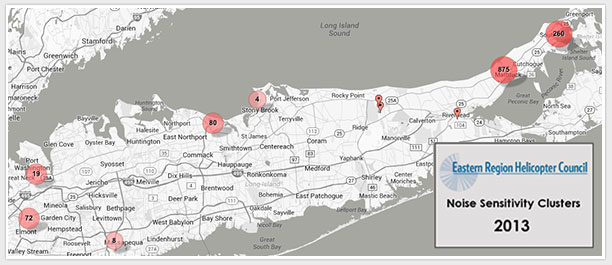Case Studies
Eastern Region Helicopter Council
PlaneNoise Guides Long Island Helicopter Noise Reductions
In the New York Metropolitan Area, from Manhattan’s West Side to Brooklyn Heights to Long Island's East End and several communities in-between, helicopter noise remains a major source of irritation and annoyance for residents, community groups and their elected representatives. Many are proposing further restrictions, increased regulation, new flight paths, even elimination -- anything to solve this growing quality of life issue. Voluntary measures already undertaken by the Eastern Region Helicopter Council, (ERHC), the Federal Aviation Administration, local airport management and elected officials have provided relief to many, yet the call remains for further action.
Before additional and more lasting solutions can be developed, the "helicopter noise problem" must be better defined and quantified. What root causes are driving the area’s noise complaints? Aircraft types? Missions? Number or frequency of trips? Altitudes and routes? Which communities are being affected? Are there commonalities between New York City’s helicopter noise complaints and those generated on Long Island’s East End? Are helicopter operators following voluntary noise abatement guidelines and “Flying Neighborly?"
Answers to these seemingly simple, but actually complex, critical questions are being found by the Eastern Region Helicopter Council through data collected and analyzed by PlaneNoise. As the leading helicopter trade organization in the Northeast US, ERHC uses PlaneNoise data to guide ongoing development and implementation of fair and equitable comprehensive noise mitigation programs.
In 2013, ERHC's PlaneNoise Complaint Box received and processed 1,848 complaints from 94 distinct households, with the majority of complaints coming from Long Island's North Fork...
ERHC has outsourced its entire noise complaint management function to PlaneNoise since 2007. In that time, over 10,000 complaints have been collected, logged, analyzed, mapped and reported on. And to ensure that decision makers are working off the same set of facts, ERHC regularly presents PlaneNoise data to its members, FAA, local airport managers as well as elected officials and their staff.
In 2013, ERHC’s PlaneNoise Complaint Box received and processed 1,848 complaints from 94 distinct households, with the majority of complaints coming from Long Island’s North Fork in the Town of Southold. The data showed that Long Island’s other helicopter noise sensitive area (based upon the number of distinct households and complaints) was located in and around Floral Park & New Hyde Park, in Nassau County.
PlaneNoise identified that over 1,400 complaints (80% of the total) were from 10 households -- six of which were located on the North Fork. By mapping each complaint it was clear that through ERHC’s voluntary noise abatement procedures Long Island’s helicopter noise issues have been reduced and contained within the two geographic areas.

ERHC uses PlaneNoise data to focus on the issues, identify noise trends and areas of concern and take quick and decisive actions through what is a voluntary and flexible mitigation structure. For example, at ERHC’s request, its members began flying a more diversified route structure to reduce high peak period traffic volumes along the North Shore and over the North Fork, and the number of households filing noise complaints dropped considerably.
PlaneNoise has allowed the Eastern Region Helicopter Council along with the FAA and interested and involved stakeholders to concentrate their efforts on developing and implementing fair and equitable North Shore/North Fork-related noise mitigation strategies and procedures. Realtime data is leading to realtime, viable solutions.

